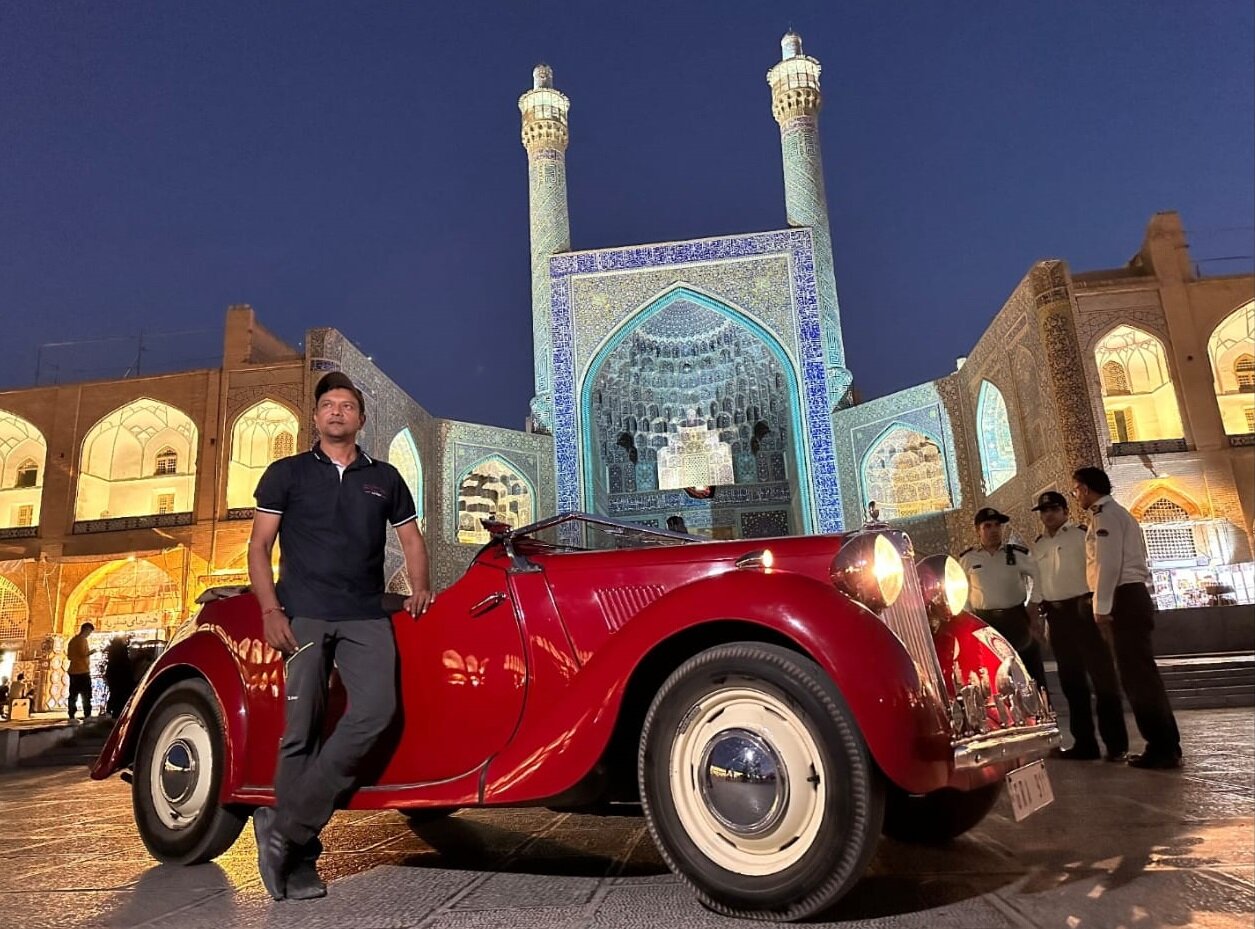Lal Pari: Indian travelers reach majestic Isfahan on 73-year-old car

TEHRAN— A team of Indian adventurers riding on a 1950 MG YT and camper van has reached Isfahan, which is widely known as “half the world”.
They entered Isfahan late on Friday to the applause of passers-by and under the auspices of the Touring and Automobile Club of the Islamic Republic of Iran. With the help of local people, we have organized various programs to welcome and accompany the group while they pass through Iranian cities, the club said.
The group embraces Daman Thakore, 50, his 75-year-old father, and 21-year-old daughter who are set to pass 16 countries to take the classic car to its birthplace of the MG factory in Abingdon.
The excursion was symbolically flagged off by Mangal Prabhat Lodha, the Minister of Skills, Employment, Entrepreneurship, and Innovation in the government of Maharashtra, in Mumbai to commemorate 76 years of India’s Independence.
The team arrived in Iran on September 2 by air among the warm welcome of local officials and travel enthusiasts. So far, the voyagers have visited attractions in several Iranian cities, such as Bandar Abbas, Lar, Shiraz, and Abadeh during their 12,000-km journey destined for England.
Their itinerary includes UAE, Iran, Azerbaijan, Georgia, Turkey, Bulgaria, North Macedonia, Albania, Montenegro, Croatia, Italy, Switzerland, Luxembourg, Germany, Belgium, and France.

Indian travelers pose for a photo during their visits to the UNESCO-registered Imam Square of Isfahan on September 9, 2023. Their classic vehicle, a 1950 MG YT, is seen in the foreground as well.
British Vintage Car 1950 MG YT built in 1950, at the factory. Which was bought in Ahmedabad in 1979 for five thousand rupees. Fondly named Lal Pari, the red classic car has stood the test of time for the family for many generations over the years.
There are between 100 and 125 such British Vintage Car 1950 MG YT models in the world. However, that decorative edition will give the message of ‘One World, One Family’ to the world. The road trip is estimated to be completed by mid-October.
They are scheduled to visit a wide variety of historical sites in Isfahan before leaving for Kashan in their circuit, which will pass through the Iranian cities of Tehran, Zanjan, and Tabriz to name a few.
Half the world?
Isfahan was once a crossroads of international trade and diplomacy in Iran and now it is one of Iran’s top tourist destinations for good reasons.
When Shah Abbas the Great became ruler of Persia's Safavid dynasty in 1587, he chose Isfahan as his capital and undertook to make it eclipse all other cities. During his reign, he built so many palaces, mosques, gardens, and bridges that the inhabitants boasted: “Isfahan nesfe Jahan”— “Isfahan is half the world.” The subtle nickname implies that seeing Isfahan is relevant to see half the world.
Shah Abbas’s immediate successors continued the beautification. According to a contemporary, Isfahan, a city of 600,000, had 162 mosques, 48 colleges, 273 public baths, and no fewer than 1,802 caravanserais — open courtyards surrounded with buildings, which served as medieval tourist parks where travelers could find water for their camels and food and lodging for themselves.
The city is filled with many architectural wonders, such as unmatched Islamic buildings, bazaars, museums, Persian gardens, and tree-lined boulevards. It's a city for walking, getting lost in its mazing bazaars, dozing in beautiful gardens, and meeting people. Moreover, it is renowned not only for the abundance of great historical bridges but also for its ‘life-giving river’, the Zayandeh Road, which has long bestowed the city an original beauty and fertility.
The cool blue tiles of Isfahan's Islamic buildings, and the city's majestic bridges, contrast perfectly with the encircling hot, dry Iranian countryside.
The huge Imam Square, best known as Naghsh-e Jahan Sq. (literary meaning “Image of the World”), is one of the largest in the world (500m by 160m), and a majestic example of town planning. Constructed in the early 17th century, the UNESCO-registered square is punctuated with the most interesting sights in Isfahan.
The square was at the heart of the Safavid capital’s culture, economy, religion, social power, government, and politics. It is hemmed on four sides by magnificent buildings: to the east, the Sheikh Lotfollah Mosque; to the west, the palace of Ali Qapu; to the north, the portico of Qeysarieh; and to the south, the eminent Imam Mosque.
AFM
Leave a Comment